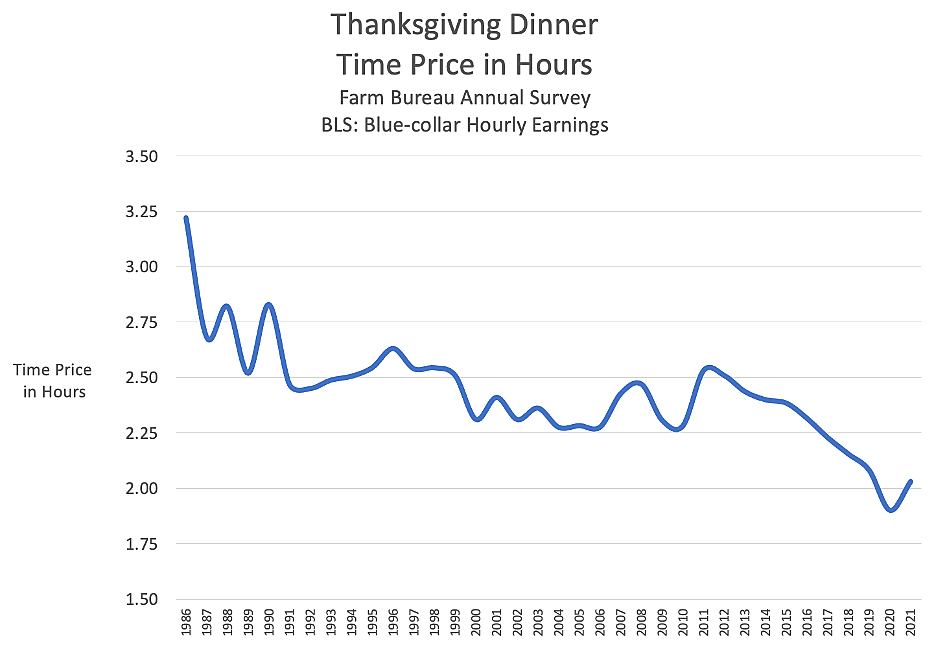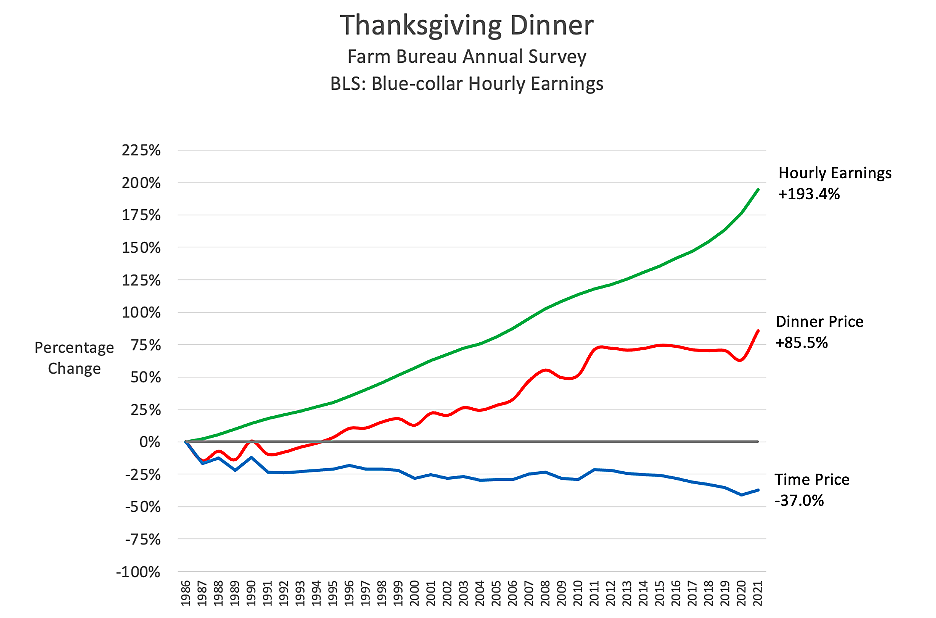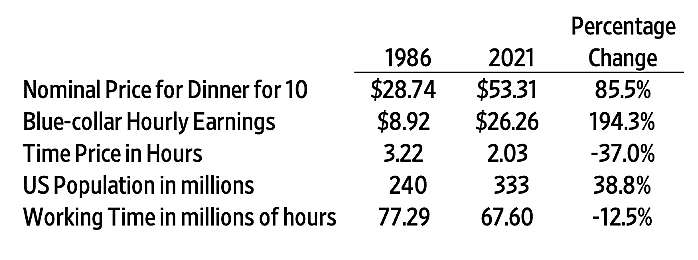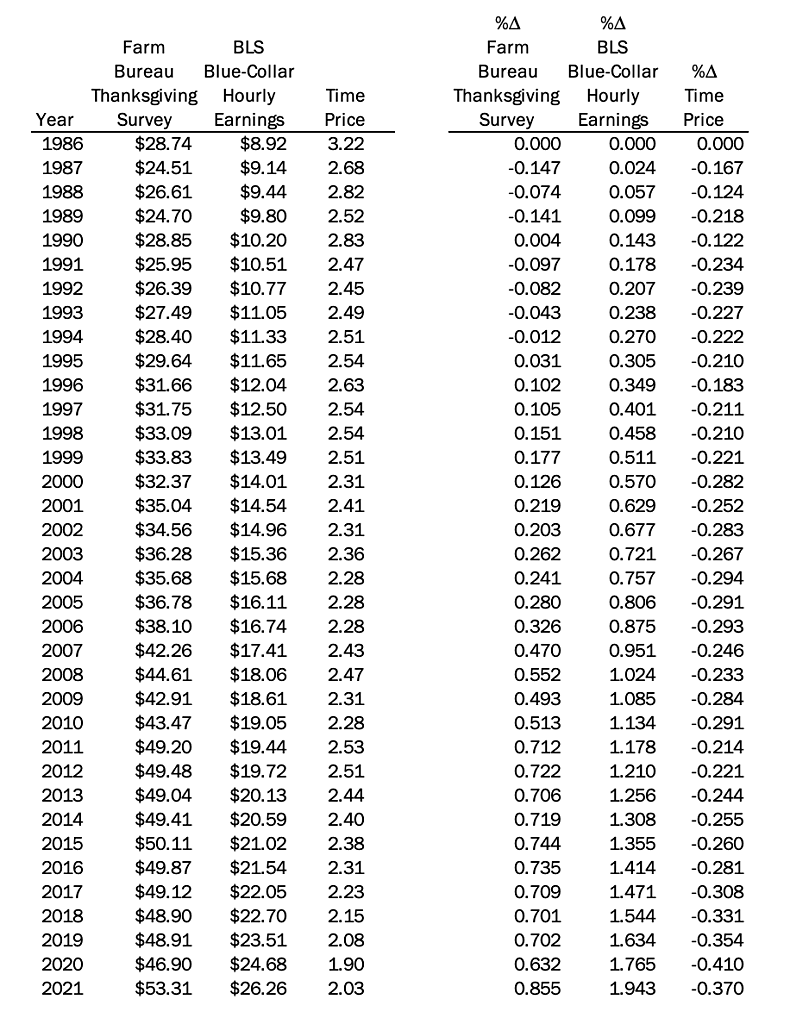Today, the U.S. Farm Bureau released its much-anticipated Thanksgiving dinner cost estimate for 2021. According to the Bureau, “the average cost of this year’s classic Thanksgiving feast for 10 [people] will be $53.31 or less than $6.00 per person. This is a $6.41 or 14 percent increase from last year’s average of $46.90.”
That much is certainly true.
However, the dire picture painted by the Bureau improves somewhat once we account for the wage increases over the course of last year. To wit, the Federal Reserve Bank of St. Louis estimates that the average blue-collar hourly wage in October 2021 was $26.26. That means that the average American will spend 2.03 hours (121.8 minutes) working to pay for the 2021 Thanksgiving dinner.
In October 2020, the average blue-collar hourly wage was $24.83, and Thanksgiving dinner cost $46.90. So, the average U.S. worker had to work 1.88 hours (112.8 minutes) to pay for the feast. That means that over the course of last year, the cost of Thanksgiving dinner rose by 9 minutes of work or 7.39 percent.
Take-away no. 1:
Once we account for the blue-collar wage increase, the rise in the cost of Thanksgiving dinner halves from around 14 percent to around 7 percent.
To be clear, that’s not the direction in which the American standard of living should be moving. Who is to blame? Part of the increased cost of Thanksgiving dinner in 2021 must surely be blamed on COVID-19 and the shock to the U.S. economy caused by the pandemic.
However, the U.S. decision-makers are not blameless. They should be more keenly aware of the additional costs imposed on the American consumer by loose fiscal and monetary policies, unnecessary regulations, trade tariffs, restrictions on energy production, and other ways in which the supply side of the U.S. economy is prevented from meeting U.S. demand.
Take-away no. 2:
Thanksgiving dinner in 2021 will be cheaper than what it was in 2019. The feast cost 2.08 hours (124.8 minutes) of work in 2019. That means that the average American worker will work 3 minutes less in 2021 than he or she did in 2019 to pay for the meal (see the table below).
Also, do not forget the long-term trend. The U.S. Farm Bureau started collecting the Thanksgiving dinner cost data in 1986. That year, the feast cost $28.74 (in 1986 dollars), while the average blue-collar hourly wage was $8.92 (in 1986 dollars). That means that the time-price of Thanksgiving dinner in 1986 was 3.22 hours or 193.2 minutes.
Take-away no. 3:
On average, the American worker will work 71.4 minutes less to pay for Thanksgiving dinner in 2021 than he or she did in 1986 (193.2 minutes – 121.8 minutes = 71.4 minutes).
It has been a difficult year for most people, and our analysis is not meant to belittle the hardship that Americans have endured since the start of the pandemic. But doom and gloom are not our friends either.
Take-away no. 4:
To wit, the time price of Thanksgiving dinner in 2021 will be 7 percent higher than it was in 2020. It will be 2.4 percent lower than it was in 2019. Finally, it will be 37 percent lower than it was in 1986.
Moreover, don’t forget the country as a whole. In 1986, the U.S. population was 240 million. That means that Americans worked 77.29 million hours to pay for Thanksgiving dinners in 1986. In 2021, the U.S. population was 333 million. That means that Americans worked 67.6 million hours to pay for Thanksgiving dinners in 2021.
Take-away no. 5:
Collectively, therefore, Americans worked 12.5 percent fewer hours to pay for their Thanksgiving dinners in 2021 than they did in 1986.
Also, note that the population of the United States increased by 38.8 percent between 1986 and 2021, while the time price of a Thanksgiving meal fell by 37 percent over the same period.
Take-away no. 6:
That means that for every 1 percent increase in the U.S. population, the time price of Thanksgiving dinner declined by 0.954 percent (–37 percent ÷ 38.8 percent = –0.954).
The average American can now buy 1.586 times as many Thanksgiving dinners as he or she did in 1986 (193.2 minutes ÷ 121.8 minutes = 1.586). The meal grew more abundant at a compound annual rate of 1.33 percent between 1986 and 2021. At that rate, Thanksgiving dinner abundance doubles every 52.6 years.
Take-away no. 7:
Between 1986 and 2021, the abundance of a Thanksgiving meal rose by 58.6 percent, while the U.S. population rose by 38.8 percent. Therefore, Thanksgiving meal abundance increased at a faster pace than population increased – a situation that we call Superabundance.
Note:
Our book, Superabundance: The Story of Population Growth, Innovation, and Human Flourishing on an Infinitely Bountiful Planet will come out in the spring of 2022.
Figure 1: Time price of Thanksgiving dinner, 1986–2021
Figure 2: Time price, nominal hourly blue-collar wage, and nominal price of Thanksgiving dinner, 1986–2021
Table 1: Time price of Thanksgiving relative to the U.S. population, 1986–2021.
Table 2: Supporting data for changes in time prices, blue-collar hourly wages, and Thanksgiving dinner costs, 1986–2021.
This post first appeared on HumanProgress.org.




